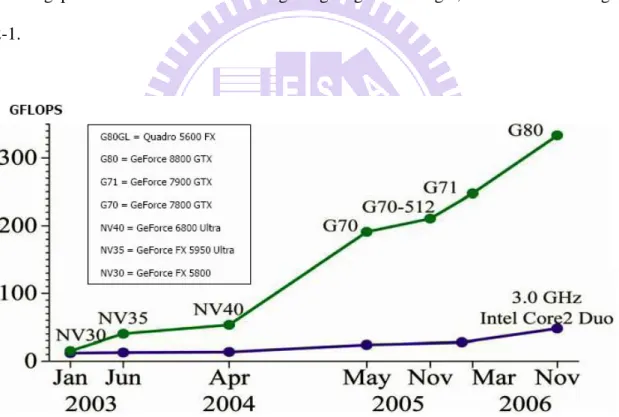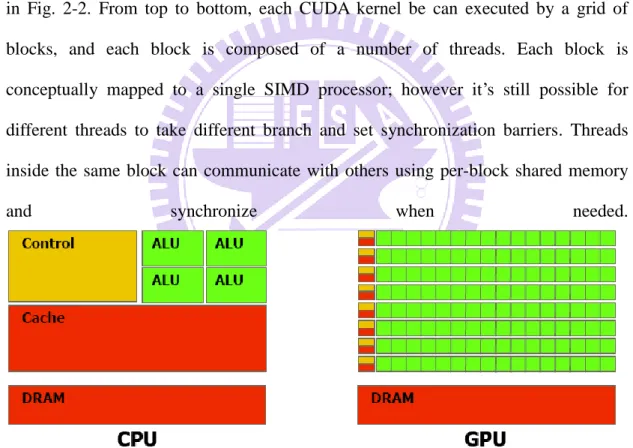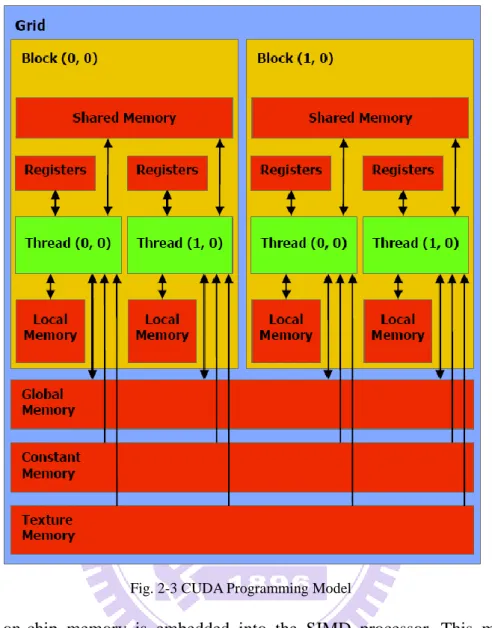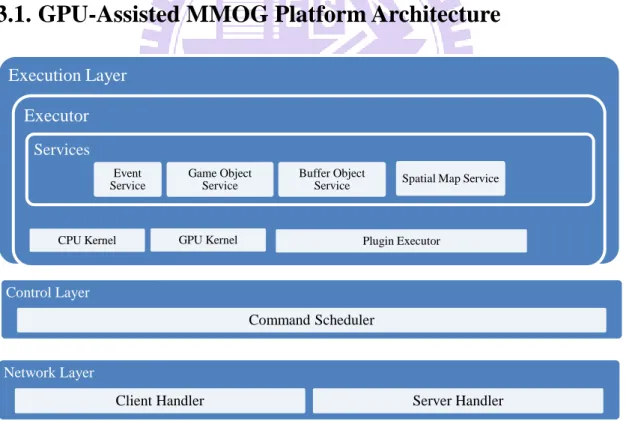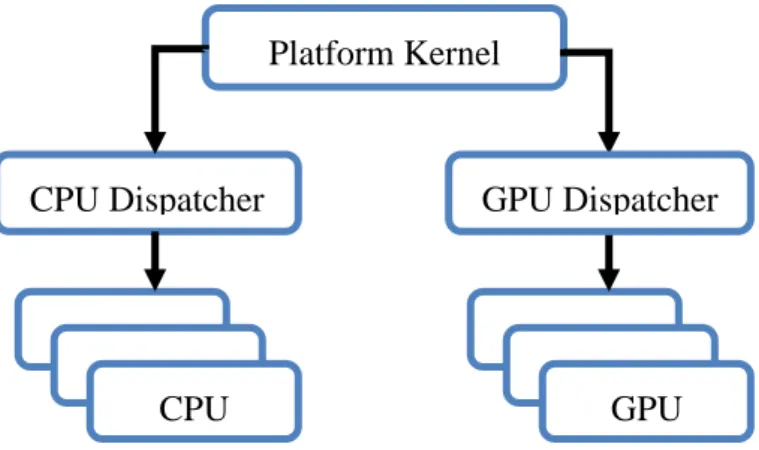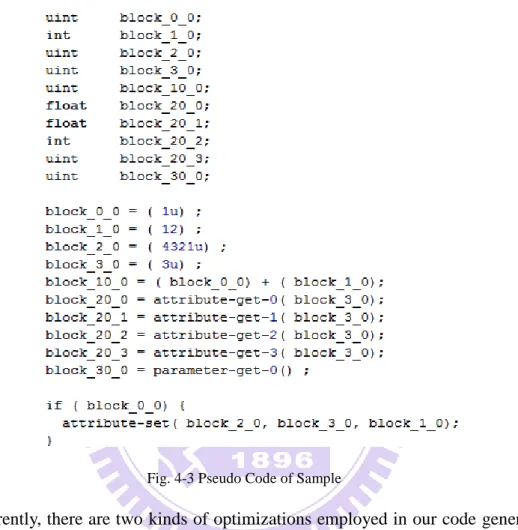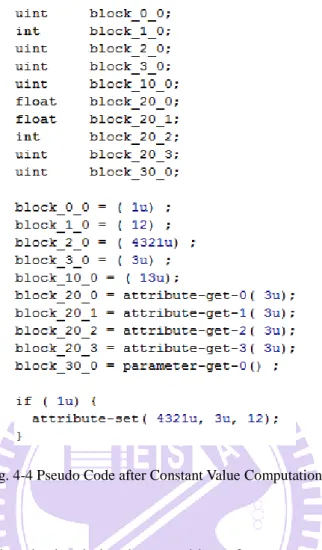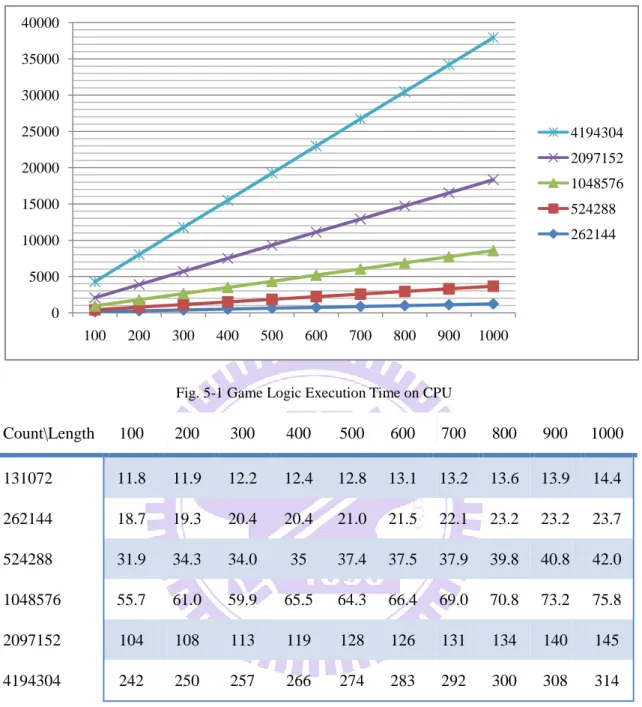國
立
交
通
大
學
資訊科學與工程研究所
碩
士
論
文
一個用於以圖形處理器為基底之線上遊戲
平
台
的
程
式
碼
產
生
器
A Code Generator for GPU-Based MMOG Platform
研 究 生:林宜豊
指導教授:袁賢銘 教授
一個用於以圖形處理器為基底之線上遊戲平台的程式碼產生器 研究生:林宜豊 指導教授:袁賢銘 國立交通大學資訊科學與工程研究所 摘要 本論文將介紹一個用於以圖形處理器為基底之線上遊戲平台的程式碼產生 器。利用此程式碼產生器,遊戲設計者可建立和管理遊戲邏輯,而不需要了解圖 形處理器程式設計的細節。為了讓遊戲設計者更容易定做他們的遊戲邏輯,我們 定義了一系列的 XML (eXtensible Markup Language)的文法,利用程式碼產生器 將該 XML 轉換為可在圖形處理器上執行的程式碼,並以插件的形式與平台共同 處理整個遊戲的運作。此外,我們針對平台在不同情況下的效能表現做了各種測 試。其結果顯示,所產生的程式碼可由該平台以平行化的方式有效率地處理從客 戶端送來的指令。
A Code Generator for GPU-Based MMOG Platform
Student : Yi-Lin Lin Advisor : Shyan-Ming Yuan
Department of Computer Science
National Chiao Tung University
Abstract
This research presents a code generator for a Graphics Processor Unit (GPU) based Massive Multiplayer Online Game (MMOG) platform. Through the code generator, game designers can construct and maintain game logics without comprehending details of GPU programming. We defined a set of eXtensible Markup Language (XML) schema for game designers to customize their game logics in a manageable way. Furthermore, we provide a code generator to translate the XML to GPU code pieces as the server plug-ins to process the entire game. In addition, several tests are performed to validate the performance of the MMOG platform in different situations. As a result, commands issued by MMOG clients can be processed efficiently by GPU-based server through the generated GPU code in parallel.
I
Acknowledgement
首先我要感謝袁賢銘教授所給予的指導,自大四專題開始即以自由明朗的風 氣帶領著我們,對於我們所做的研究,給予了最大的創意空間。另外也要感謝各 位口試委員,在百忙中抽空前來,並對論文提出了許多建議,使論文更加地完整 和嚴謹。 此外,我要感謝分散式實驗室的各位學長姐、同學和學弟妹,不管是生活上 的點點滴滴,或是學術上的各種討論,都讓這兩年間更加地充實。其中,我要特 別感謝學長葉秉哲、邱繼宏、林家鋒、高永威以及宋牧奇等,在研究過程中給了 我不少建議。還有感謝實驗室同學簡士強、周鴻仁、林辰璞和謝明志,在這兩年 中的互相激勵和幫助。 最後,我要感謝父母從小的教誨,給予我良好的學習環境,使我能夠專心於 做學術上的研究,謹以這篇論文來感謝您們的養育之情。II
Table of Contents
Acknowledgement ... I Table of Contents ... II List of Tables ... IV List of Figures ... V 1. Introduction ... 1 1.1. Preface... 1 1.2. Motivation ... 1 1.3. Problem Description ... 2 1.4. Research Objectives ... 4 1.5. Research Contribution ... 52. Background and Related Work ... 6
2.1. Graphics Processor Unit (GPU) ... 6
2.1.1. Compute Unified Device Architecture (CUDA) ... 7
2.1.2. Close to Metal (CTM) (AMD Stream™) ... 11
2.2. Related Work ... 11
3. Customizable GPU-Assisted MMOG Platform ... 13
3.1. GPU-Assisted MMOG Platform Architecture ... 13
3.1.1. GPU and CPU Kernel ... 14
3.1.2. Plug-in Executor ... 15
3.1.3. Event Service ... 15
3.1.4. Game Object Service ... 16
3.1.5. Buffer Object Service ... 16
III
3.2. Game Logic Customization ... 17
3.2.1. Code Generator Architecture ... 18
4. Implementation Details ... 20
4.1. Configuration File Format ... 20
4.2. Code Generation ... 23
5. Experimental Result and Analysis ... 28
5.1. Experiment Configuration ... 28
5.2. Results ... 29
5.2.1. Logic Execution Performance ... 29
5.2.2. Branching Overhead ... 33
6. Conclusions and Future Work ... 36
6.1. Conclusions ... 36
6.2. Future Work ... 36
IV
List of Tables
Table. 2-1 Memory Addressing Spaces Available in CUDA ... 9
Table. 4-1 Available Tags ... 22
Table. 4-2 Available Types of Block tag ... 23
Table. 5-1 Hardware Configuration ... 28
Table. 5-2 Graphic Card Configuration ... 29
Table. 5-3 Software Configuration ... 29
Table. 5-4 Game Logic Execution Time on CPU ... 30
Table. 5-5 Game Logic Execution Time on GPU ... 31
Table. 5-6 Execution Time of Different Branches on CPU ... 34
V
List of Figures
Fig. 2-1 Floating-Point Operations per Second for the CPU and GPU ... 6
Fig. 2-2 GPU Devotes More Transistors to Data Processing ... 8
Fig. 2-3 CUDA Programming Model ... 10
Fig. 3-1 GPU-Assisted MMOG Platform Architecture ... 13
Fig. 3-2 Architecture of Code Generator ... 18
Fig. 4-1 Sample Configuration File ... 20
Fig. 4-2 Work Flow of Customized Platform ... 25
Fig. 4-3 Pseudo Code of Sample... 26
Fig. 4-4 Pseudo Code after Constant Value Computation ... 27
Fig. 5-1 Game Logic Execution Time on CPU ... 31
Fig. 5-2 Game Logic Execution Time on GPU... 32
Fig. 5-3 Setup Times of Different Command Count on GPU ... 32
Fig. 5-4 Execution Time of Different Branches on CPU ... 34
1
1. Introduction
1.1. Preface
As the network technology evolved, MMOG (Massive Multiplayer Online Game) has become the one of the largest computer game industry. Each MMOG forms a virtual world, within which people act and live together. No matter where they are, the virtual world connects them in the same space, at the same time.
1.2. Motivation
MMOG is sweet and sour for most game company. The sweetness comes from the fact that no private copy is possible because everyone needs to connect to the virtual world, thus increase the revenue. On the other hand, the sourness is high cost and long development cycle. Because there are several critical aspects needed to address even for a simplest MMOG, such as networking which requires enterprise-level reliability, stability and scalability to supply tens of thousands player concurrently.
To ease the overall MMOG development, several middleware solutions exist both in commercial market and open source community. They all have the same goal to support the online game development and to shorten the development cycle by reducing the building complexity. Although there is no in-depth comparison between these solutions, but generally speaking, in terms of scalability and robustness, they are not good enough as what we expect. According to some statistics, all real-world online games fail to scale up to more than 200k players, so that the game operator
2
usually gives more shards (i.e. a separate virtual world) as the number of subscriber grows. Each shard is running on a server cluster consists of about 5 to 20 servers to form a virtual world with thousands of concurrent users. The number of concurrent players on each server is about hundreds to thousands, which is pretty small. Meanwhile, players in different shards cannot communicate or interact with each other because they are physically separated world and this makes shard design less-attractive.
As shard is less-attractive, there are some research works and middleware trying to break the shard boundary to make it a shard-less design. For example, Sun Microsystems initiate an ambitious project called Darkstar [1] to build a large and shard-less virtual world, but the project doesn‟t seems to actually solve the problem from their latest benchmark numbers, and also the cost for entire server cluster still remains high and unaffordable for small game companies.
In this thesis, we look into the scalability problem existed in most commercial and open source middleware solutions, and propose a solution to scale up to a very large number of concurrent players in single server while maintaining the ease of use in overall game development.
1.3. Problem Description
Designing a flexible, scalable, customizable, and also easy-to-use MMOG platform is challenging. Among all, the most critical factor of a MMOG platform is still the performance which refers to scalability. Scalability usually a key of cost for operations because the better scalability a platform has, the fewer clusters operator needs to deploy. In additional to scalability, flexibility and ease of use of a MMOG platform are also significant. Flexible and customizable designs would give more
3
possibility for game designer to construct more complicated game play, which can really make differences in competitive online game market.
To give better understanding of the problems, we first elaborate some design pattern and common constraints in MMOGs. Almost all MMOGs are based on command-update communication model in which every players uses a client application to send commands to the server and receive updates in return. For each command, server needs to process the request through a specific game logic and sends updates back in a limited timeframe. The timeframe depends on game genre, and, for example, most MMORPG requires 200ms response time to deliver a smooth game play, and MMOFPS usually requires less 70ms to make it playable. Many research works have been conducted to reduce the latency, but most of them attack the problem from the network perspective. They tried to reduce the network latency by proposing different network topologies. Proposed communication architecture includes peer-to-peer and scalable server/proxy architecture. They have succeeded to alleviate the network latency between server and client. However the number of concurrent player per server is far from 10,000 even if the network latency has been improved by various works.
In our point of view, as the network technology evolved, the network latency is getting lower and lower and has dropped to a certain level. The bottleneck becomes the client command processing on server-side. As the number of players grows, the number of client commands needed to be processed in the limited timeframe increases. However, the current design of CPU is not capable of processing such a huge amount of commands in the limited timeframe. Although recently multi-core CPUs are introduced, the cache-misses occurred for different execution context of game logics and network handlers, and the synchronization among threads or processes will even
4
lower the CPU processing capability of client commands when lock is needed to avoid update conflict to guarantee consistent results.
Because of the limit, we started to investigate the source the problem and found it the result of sequential nature of CPU processing. In our previous work, we give the answer for this problem: make it parallel by using GPU. For the last decade, GPU had evolved into a powerful array of general SIMD processer instead of just being a simple 3D accelerating silicon. To date, the computation power of GPU is hundreds of times more than that of CPU, and it‟s believed that the GPU computation power will continue to supersede Moore‟s Law, while CPU has hit a barrier.
Although light has been spotted on GPU, converting a sequential program to a parallel one is not straightforward. Algorithm needs to be re-designed and data structure needs to be re-organized to reflect the different access pattern in parallel programming. Several attempts have been made to exploit GPU computation power to general problem such as collision detection [2] and online database processing [3]. For MMOG, the world first GPU-assisted MMOG platform is proposed in [14]. However it is still not a “full-featured” platform in terms of flexibility and ease-of-use. Due to the fact that most programmers or game developers are not familiar with parallel programming or GPU programming, it‟s still not possible to build an online game server that is accelerated by GPU computation.
1.4. Research Objectives
In this thesis, we try to give a more modular GPU-assisted MMOG platform, and provide way for game designer to construct game logics processed on GPU without the knowledge of parallel programming or GPU programming. As we don‟t require game designer to write real GPU code, an interface that bridges game logic design
5
concept to real code is needed, which is basically a code generator. In addition, various optimization of code generator needs to consider further enhance the server performance , thus increase the scalability of the platform.
1.5. Research Contribution
We discusses several issues and problems to build a MMOG platform with flexibility, scalability and customizability while handling client commands and create updates on both CPU and GPU. Because of the architecture difference between CPU and GPU, platform itself has been re-designed to exploit the CPU/GPU computation power by generating compatible code on both CPU and GPU. We define a set Extensible Markup Language (XML) schema for game designer to customize their game logic and provide a code generator to translate the XML to GPU code pieces as the server plug-ins to process the entire game play. A number of regression tests are performed to validate the correctness and robustness of the code generator and demonstrate the efficiency of GPU-assisted MMOG platform. As a result, commands issued by MMOG clients can be processed efficiently by GPU-assisted server through the generated GPU code in parallel.
6
2. Background and Related Work
2.1. Graphics Processor Unit (GPU)
The GPU technology has changed a lot in a last few years, both in hardware and software.
The hardware structure has transformed from fixed function rendering pipeline to programmable pipeline consists of multiple SIMD processors. The computation power gap between CPU and GPU is getting larger and larger, as described in Fig. 2-1.
Fig. 2-1 Floating-Point Operations per Second for the CPU and GPU
For software, OpenGL persists but several extensions added by OpenGL ARB [4] for usage of the programmable pipeline. Base on programmable pipeline and the SIMD architecture of current GPU, there is a new kind of computing method called general computation on graphics hardware, also called GPGPU [5][6].
7
The concept of the computing method is first to map a compute-intensive problem into multiple small pieces, then solve the small pieces within pixel-rendering context (this is now programmable) and finally store the result into frame buffer object.
This method has extremely good performance for compute-intensive problem, like matrix operations [7][8]. However the implementation is hard for programmers not familiar to graphics processing because of the texture processing. For the general processing purpose on GPU, the two largest graphics manufacturers, NVIDIA and AMD/ATI, give different answer to developers toward GPGPU. NAVDIA proposed Compute Unified Device Architecture (CUDA) while AMD/ATI threw Close-To-Metal (CTM), which becomes AMD Stream technology later. Here we give a briefly introduction for these two technologies.
2.1.1. Compute Unified Device Architecture (CUDA)
For general purpose computing usage on GPU, NVIDIA released CUDA for developers to speed up there program on their G80/G92 based GPU. It‟s the architecture that unifies the general computation model on graphics devices. CUDA use C language with extensions from C++, such as template and variable declaration in C++ style. This makes a great convenience for programmers. Here we give more details for CUDA because the platform is entirely implemented in CUDA.
CUDA is very different from OpenGL and other programming languages. Compared to traditional GPGPU approach, the most important advantage of CUDA is the “scatter write” capability. Scatter write, by definition, is that in CUDA code you can write any data to arbitrary address in GPU memory, which is not possible in traditional GPU shader programming. With this capability, many of parallel
8
algorithms are possible implemented on GPU, such as parallel prefix sum and bitonic sort.
In addition, for communication and synchronization, there is shared memory on each multiprocessor, which can be shared among sub-processors. Shared memory has extremely high bandwidth compared to onboard GPU memory and can be used as user-managed cache.
Furthermore, as stated in CUDA official document, GPU is capable of executing a large number of threads in parallel with very low context switch overhead as shown in Fig. 2-2. From top to bottom, each CUDA kernel be can executed by a grid of blocks, and each block is composed of a number of threads. Each block is conceptually mapped to a single SIMD processor; however it‟s still possible for different threads to take different branch and set synchronization barriers. Threads inside the same block can communicate with others using per-block shared memory
and synchronize when needed.
9
Table. 2-1 Memory Addressing Spaces Available in CUDA
Except for shared memory, actually there are six different types of memory for different purpose and access pattern, listed in Table. 2-1. The GPU memory layout is shown in Fig. 2-3. In fact, physically there are only two types of memory physically available on GPU: on-chip memory and off-chip memory. But for difference usage, they are divided into difference memory space and optimized for different purpose.
Name Accessibility Scope Speed Cache Register read/write per-thread zero delay (on chip) X Local Memory read/write per-thread DRAM N Shared Memory read/write per-block zero delay (on chip) N Global Memory read/write per-grid DRAM N Constant Memory read only per-grid DRAM Y Texture Memory read only per-grid DRAM Y
10
Fig. 2-3 CUDA Programming Model
The on-chip memory is embedded into the SIMD processor. This make the access extremely fast, which takes only 2 clocks to read or write when no bank conflict is occurred. Compared to on-chip memory, access to off-chip memory is very expensive which takes 200~300 clocks each operation. On-chip memory, which is usually refer to shared memory, is typically used as a user-manageable cache for SIMD processors to avoid duplicated access to off-chip memory. Also, shared memory can be used as for inter-communication among threads in the same block.
CUDA seems to be the best choice for parallel programming, but there are some limitations due to hardware design. First of all, the precision of floating point computation is limited. Only single precision floating point is supported right now. .
11
Second, there‟s no recursive function allowed on GPU, simply because stack is not presented on GPU. Third, the branching of threads within same block has some performance issue because that each block is a single SIMD processor which can only execute a single instruction at a time. If different threads take different branch paths, they will be serialized by the thread scheduler on GPU, thus penalty is introduced. Fourth, the data transfer between CPU and GPU memory is relatively slow due to the limited bandwidth of PCI Express bus. For more details, please refer to official CUDA programming guide [9].
2.1.2. Close to Metal (CTM) (AMD Stream™)
In comparison with CUDA, AMD/ATI announced the Close To Metal (CTM) [10] technology before CUDA. For similar goal of CUDA, CTM try to open the computation power of GPU and apply to general purpose computation. But instead of CUDA, CTM comes with no comprehensive toolkits. There are no compiler, linker and high-level language interface but only low-level, assembly like raw commands executable on AMD/ATI‟s GPU. The differences set a barrier for developers and make it less-attractive, even though the CTM covers almost all aspects that CUDA can do. Recently AMD made a swift to its strategy to add a higher level abstraction over CTM called Compute Abstraction Layer (CAL), and combine with Brook+ as AMD Stream Computing SDK. However, the development progress is still slow compared to CUDA and Brook+ is not as flexible as CUDA. That‟s why we choose to use CUDA finally.
2.2. Related Work
12
designer, we reviewed some popular game development tools and middleware here. Basically online game development involves many aspects, and one of the most important jobs is to design the game logic both in server-side and in client-side. Many tools exist nowadays to facilitate client-side game design such as popular Virtools [11].
Virtools provides an integrated development environment with many build-in functionalities such as 3D animation, logic design, world design and several add-on components such as physics, AI, and networking. The tool design is very flexible and allows creating games on many devices like PCs, web browsers, and even popular game consoles. The main design idea in Virtools is called „building block‟ which represents an action, or said game logic. It abstracts the programming details and visualizes the logic as a flow chart, which is extremely easy for game designers. Virtools successfully reduced the complexity of game logic development by such modular design, so we adopt a similar concept in our code generator.
As for server-side middleware, many commercial products are available such as HeroEngine [15], Multiverse [16], and Bigworld [17]. Meanwhile, project DarkStar [1] and DOIT [12][13] are developed by open source community and our research lab. They adopt similar network architecture to improve the network scalability while maintaining low latency by adding an additional gateway layer between server and client. The gateway-server architecture has been proven to reduce the network latency without any compromise of scalability, flexibility, high-performance and ease-to-use. For game development customization and enhancement, both of them provide java-based plug-in framework and flexible network protocol.
13
3. Customizable
GPU-Assisted
MMOG
Platform
In this chapter, we will describe how the MMOG platform is GPU-assisted and customizable. We proposed a modular platform. Each module serves as different role and provides different functionalities. Some of the modules make use of GPU to improve the processing performance, and since the capability of GPU is still limited to general computation, some modules are still running on CPU. We will give detailed explanations for each module in the following section.
3.1. GPU-Assisted MMOG Platform Architecture
Fig. 3-1 GPU-Assisted MMOG Platform Architecture
The entire system architecture is depicted in Fig 3-1. Basically, system is divided
Execution Layer Executor
GPU Kernel Plugin Executor
CPU Kernel Services Event Service Buffer Object Service Game Object
Service Spatial Map Service
Control Layer
Command Scheduler
Network Layer
14
into three layers: network layer, control layer, and execution layer.
The network layer is the front-end interface between server and client. Commands from clients are first parsed by client handler, and then pass to the control layer. Some commands are not processed locally such as chatting to redirect to other server node through server handlers. The server handler will handle these kinds of network messages and make other separate services work with game server together.
In the control layer, server will translate commands into objects and send to command scheduler to wait for execution. The command scheduler will then dispatch each command to different executor in a batched manner, and finally collect the result from executor to reflect updates back to clients.
Execution layer is the logical processing layer in game server. Each command will be dispatched to either CPU or GPU specified by control layer, and then execution layer performs the actual processing on CPU and GPU. Execution layer hides the underlying details and abstracts the processor to provide a uniform game logic execution environment. In following section, we further elaborate each important module execution layer, and explain the relationship among them.
3.1.1. GPU and CPU Kernel
GPU/CPU kernel is the most important module in execution layer. It provides a uniform environment and abstracts the underlying processor unit by providing several primitives running on both CPU and GPU. Resource initialization such as memory allocation and thread pool allocation are all implemented in this module. The kernel module is responsible for initializing other execution-related modules such as plug-in executor module, event service module, game object service module, and so on.
15
3.1.2. Plug-in Executor
Game logics can be seen as a set of plug-in in our platform. Plug-in can be executed on either CPU or GPU by plug-in executor, which provides some basic programming construct to hide the complexity of programming on CPU and GPU, so plug-in code can be reused for CPU execution as well as GPU execution. Plug-in Executor is also responsible for controlling each service module to generate correct result, and all services are controlled by plug-in executor. For example, if a game object creation request is made during the plug-in execution, the plug-in executor needs to ask game object service to process the request the get a new game object id back. Such post-processing or pre-processing works are carried out at each service module, but they are all invoked by plug-in executor.
3.1.3. Event Service
Plug-in executor collaborates with event service to invoke corresponding plug-in in different execution context. Each plug-in can be triggered by one or many events, which can be dispatched through event service. Furthermore, we provide java style “synchronized method” design to solve the synchronization issue. We allow a plug-in to be executed in a “synchronized” way, that is, all invocations to that plug-in will be serialized to avoid inconsistency. Although such design would reduce the parallelism and introduce penalty to overall execution, it‟s still crucial to synchronize concurrent modification to a shared variable, which is unavoidable in most game design.
As mentioned earlier, plug-in can be executed on either GPU or CPU in either synchronized or non-synchronized way, so we can say an event must belong to one of the 4 different scopes: CPU non-synchronized, CPU synchronized, GPU
16
non-synchronized, GPU synchronized. So, if a plug-in is triggered by a CPU synchronized event, it will be executed on CPU in a synchronized way. By analogy, if a plug-in is triggered by a GPU non-synchronized event, it will be executed on GPU in a non-synchronized way. Also, dispatching an event that belongs to different scope (from current one) is allowed. For example, you can dispatch a CPU synchronized event within a GPU non-synchronized plug-in and vice versa.
Event service is also the key to decouple the dependency of different plug-ins, and to chain plug-in execution, even they are in different scope.
3.1.4. Game Object Service
To talk about game object service, we need to define what a game object is and how it can be used. Game object represents a persistent entity in the virtual world. Each game object has several attributes, which allows game logic to obtain some information about a specific game object. For example, a player in the virtual is represented as a game object of one type; a building in the virtual world is represented as another game object of different type. Regardless their types, they all have same number of attributes, even though their meaning could be different.
Now step back to game object service. Basically, game object service is the main persistent storage of game object. It provides a set of APIs to get/set game object attributes, create/destroy game object, get/set type of a game object, and so on. Game object service manages all game objects and synchronizes the GPU storage with CPU storage.
3.1.5. Buffer Object Service
17
persistency, buffer object service is used to manage transient data set. Buffer object is used to hold temporary result, such as a list of neighborhood id, or a buffer array to store update results. Each buffer object is only valid until the end of next iteration of plug-in execution, so a typical use of buffer object is parameter passing between different plug-ins in different execution scopes. For example, by using buffer object, we can save some intermediate result in a buffer object, and pass the buffer object id as the parameter for the event triggering next plug-in in the execution chain, and load the intermediate result back to the plug-in and continue processing.
3.1.6. Spatial Map Service
The spatial map service provides the range search primitive which is widely used in most MMORPG to find out nearby players when an update needs to be broadcasted. Basically we implement this service on GPU by using the method in [14], but in addition, we extend the existing 2D range search to support both 2D and 3D spatial queries. Range query can be requested as a square range query in 2D or a cubic range query in 3D to support various game designs including MMORPG, MMOFPS, and MMORTS.
3.2. Game Logic Customization
Given that modular design of the GPU-assisted MMOG architecture, the game development work is still not hard without effective tools to help game designer design logics and write compatible GPU code. In addition, as GPU lacks of debugging capability, we need to a translation of game logic in some high level representation instead of real GPU code to be able to simulate the logic. The high level representation is imperative not only for debugging but also for developing some
18
GUI tool to make the platform easy to use. Therefore, we defined a configuration file format to describe any game logic flow and context. Code generator is implemented to translate the configuration file to real GPU routines provided by the platform.
3.2.1. Code Generator Architecture
Fig. 3-2 is the architecture of the code generator. There are three important components in the generator, which are configuration parser, analyzer and generator. The generator will take a configuration file and output the corresponding code for GPU and CPU.
In order to transform the configuration file to code, we need to parse the configurations first, which is the job of configuration parser. But the parser doesn‟t know the details of each object, so we provide some allocators which are closer to the implementation. By using the allocators, parser will pass part of the configuration to allocators to generator corresponding objects. After parsing, there will several collections allocated by allocators to be shared by other components. With these collections, other components could know the description of the configuration file.
Code Generator Object Collection Analyzer Generator Configuration Parser Block Allocator Logic Collection Block Collection Object Allocator Logic Allocator
19
After that, we need to check the relationship between objects, logics and blocks, which is completed by analyzer. Finally, the generator generates the corresponding code for the configuration file.
20
4. Implementation Details
In this chapter, we describe the current implementation of this work. Since the platform implementation detail can be found in [14], we focus on code generation part only.
4.1. Configuration File Format
In current implementation, the configuration file provides descriptions of game objects and game logics. As shown in Fig. 4-1, for game object, designers can describe the attributes along with storage types as the specification of a type of game object by using <game_object> tag. For game logic, execution sequence can be by grouping <block> tags within a <logic> tag.
21
Enclosed by <game_object> tag, <attribute> tags are used to describe the attributes which is owned by the game object with logical index and storage type. In this way, we can define different types of game objects with different numbers of attributes.
Compared to <game_object> tag, which describes static data structure, the <logic> tag defines dynamic behaviors of game play. We use <block> tag to define a single action and chain all actions by using the “next” attribute in the <block> tag. The first block id is specified in “boot” attribute of the <logic> tag. The “type” attribute in each <block> tag indicates the real action taken by this block, as summarized in Table. 4-2. Furthermore, <input> and <branch> tags are used under <block> tag to define the input of this block and spawn new execution sequence if conditions applied.
By using <input> tag, every <block> tag can have none or one or many outputs. For example, if the type of the block is “attribute_get”, the number of outputs depends the number of attributes in the game object specification. The “source” and “source-index” attribute in the <input> tag is used to specify the “source-index”-th output of the “source” block. All available tags are summarized in Table. 4-2.
The <branch> tag in a <block> tag spawn a new execution sequence if the given condition applied. The execution will continue on the new branched block, and return to the current block when the new execution reaches its end.
22
Tag Name Parent Tag Attributes Optional Attribute Description Root N
game_object Root Id N Unique Identifier attribute game_object Index
Type
N N
Logical index in game object Storage type of attribute Logic Root Id
Boot
N N
Unique Identifier First executed block Block Logic id type next N N Y Unique Identifier
Pre-defined function block Next executed block Input block index
source source-index N N N Index of input Source of input Source index of input branch Block index
block-id
N N
Index of branch Executed block
23
Type Classes Types Input/Branch/Output Additional Required Attributes Arithmetic Plus
subtract multiply divide
2 / 0 / 1
Attribute_get attribute_get 1 / 0 / Variable reference-id (Type of game object) Attribute_set attribute_set 3 / 0 / 0 reference-id (Type of game object)
Condition condition 1 / 1 / 0
Constant constant 0 / 0 / 1 constant-value
constant-type (Storage type) Loop loop 1 / 1 / 0
Parameter parameter 0 / 0 / 1 parameter-type (Storage type) parameter-index (Logical index)
Table. 4-2 Available Types of Block tag
4.2. Code Generation
We implemented a code generator to translate the configuration file to desired GPU routines on our platform. In terms of architecture, there are three top-level components in the code generator as shown in Fig. 3-2: Configuration Parser, Analyzer and Generator.
Configuration parser parses the input and makes use of object allocator and logic allocator to make instances of game object and game logic according to the given configuration. In addition, game logic will use block allocator to get the instances of blocks described in configuration file. Theses object instances are stored in
24
corresponding collection. (i.e. game object instances are stored in the object collection, and game logic instances are stored in the logic collection respectively.)
Next, Analyzer analyzes the relationship among game logics and blocks, and checks the validity of the configuration by tracing the link between game logic instances and game object instances from top to bottom. Because there could be many invalid descriptions in a configuration such as invalid of inputs, non-unique identifier, and input count mismatch, corrupted routine may be generated with erroneous configuration and leads to incorrect runtime behavior of our platform. So it‟s crucial to remove any inconsistency in the configuration file. More code generation constraints can be considered and checked in this stage.
After validation of configuration, the Generator generates the corresponding GPU platform routines according to the given specification on a block-by-block basis. The generated routines conform to several specifications: CUDA language specification for GPU routine, C++ language specification for CPU routine, and the standard application interface of the platform.
Fig. 4-2 demonstrate the different pieces of code that would be generated by our code generator to plug customized game logic into our GPU-assisted MMOG platform. Generator needs to produce game logic code body as well as the logic dispatcher for both CPU and GPU execution. The dispatcher is used to invoke different game logic by different events. During the platform execution, the plug-in executor module will call the dispatcher and tell the event type along with an event parameter. The dispatcher then uses the information from the platform kernel and invokes the corresponding game logic. After finishing the execution of game logic, the dispatcher returns the control of execution back to the platform.
25
Fig. 4-2 Work Flow of Customized Platform
Take a step further, in the code analysis and generation stage, each functional block instance supplies following interfaces for Analyzer and Generator:
Analyzer uses the pre_analysis_impl() and analysis_impl() to perform functional analysis. The pre_analysis_impl() checks if all input references are valid, but no actual code analysis is performed here. The analysis_impl(), on the other hand, performs code analysis as well as code optimization. Take the condition block as an example, we check if the id of the branch block is valid in the pre_analysis_impl(), and perform constant value computation, if any, in analysis_impl().
As for Generator, it makes use of generate_declaration_impl() and
generate_content_impl() after analysis stage. The generate_declaration_impl()
generates the declaration of variables at the beginning of the code because variables might be shared among following functions. Also, this is required if we want to
𝑣𝑜𝑖𝑑 𝑝𝑟𝑒_𝑎𝑛𝑎𝑙𝑦𝑠𝑖𝑠_𝑖𝑚𝑝𝑙(𝑙𝑜𝑔𝑖𝑐 &𝑝𝑎𝑟𝑒𝑛𝑡) ;
𝑣𝑜𝑖𝑑 𝑎𝑛𝑎𝑙𝑦𝑠𝑖𝑠_𝑖𝑚𝑝𝑙(𝑔𝑎𝑚𝑒_𝑜𝑏𝑗𝑒𝑐𝑡_𝑐𝑜𝑙𝑙𝑒𝑐𝑡𝑖𝑜𝑛 &, 𝑙𝑜𝑔𝑖𝑐 &);
𝑣𝑜𝑖𝑑 𝑔𝑒𝑛𝑒𝑟𝑎𝑡𝑒_𝑑𝑒𝑐𝑙𝑎𝑟𝑎𝑡𝑖𝑜𝑛_𝑖𝑚𝑝𝑙(𝑐𝑜𝑛𝑓𝑖𝑔 &, 𝑐𝑜𝑛𝑠𝑡 𝑙𝑜𝑔𝑖𝑐 &, 𝑜𝑢𝑡𝑝𝑢𝑡_𝑠𝑡𝑟𝑒𝑎𝑚 &); 𝑣𝑜𝑖𝑑 𝑔𝑒𝑛𝑒𝑟𝑎𝑡𝑒_𝑐𝑜𝑛𝑡𝑒𝑛𝑡_𝑖𝑚𝑝𝑙(𝑐𝑜𝑛𝑠𝑡 𝑐𝑜𝑛𝑓𝑖𝑔 &, 𝑐𝑜𝑛𝑠𝑡 𝑙𝑜𝑔𝑖𝑐 &, 𝑜𝑢𝑡𝑝𝑢𝑡_𝑠𝑡𝑟𝑒𝑎𝑚 &) ;
Platform Kernel CPU Dispatcher CPU Logic GPU Logic GPU Dispatcher
26
generate other GPU language which requires C-style variable declaration. (i.e. all variables must be declared in the beginning to allocate register space.) Fig. 4-3 is the pseudo code without optimization generated by the sample configuration.
Fig. 4-3 Pseudo Code of Sample
Currently, there are two kinds of optimizations employed in our code generator: constant value computation and unused block stripping. We analyze the code to find out all implicit constant values and output the so-called “constant blocks”, which has a single constant property. Fig. 4-4 is an example of the pseudo code after the first optimization.
27
Fig. 4-4 Pseudo Code after Constant Value Computation
The unused block stripping is implemented by reference counting. The reference count indicates how many blocks are referencing to it. Therefore, blocks could be stripped itself out if all the outputs are not referenced. After applying the unused block stripping on the example code in Fig. 4-4, the code will be reduced to a single line:
28
5. Experimental Result and Analysis
In this chapter, we try to evaluate the performance of our MMOG platform and compare with naïve CPU approach along with basic game logic generated by our code generator. As we tried all our efforts to deliver the most MMOG platform performance, different game logic design can result in different overhead. Considering the different architecture of GPU from that of CPU, we give two scenarios to illustrate the possible performance penalty. As we focus on the computation part, the command transmission time between client and server is ignored in all test cases. Each scenario runs for 32 times and we make an average for each of them.
5.1. Experiment Configuration
To work with CUDA, we have the following hardware configuration:
CPU Dual-Core AMD Opteron 2216 x 2 Motherboard TYAN Thunder n6550W (S1925) RAM 2G DDR2 667 x 4
GPU NVIDIA GeForce 8800 GTS 512M
Table. 5-1 Hardware Configuration
Since the performance comparison of CPU and GPU is performed, we list the specification of the GPU in details as follows:
29
Processor Name GeForce 8800 GTS 512M (G92) Number of SIMD Processor 16 (each contains 8 cores) Number of Registers 8192 (per SIMD processor) Constant Cache 64K (per SIMD processor) Processor Clock Frequency Shader: 1625 MHz, Core: 650 MHz Memory Clock Frequency 970 MHz
Shared Memory Size 16K (per SIMD processor) Device Memory Size 512MB DDR3
Table. 5-2 Graphic Card Configuration
As for software part, we use CUDA 2.0 beta released recently. Previous version 1.1 suffers from several bugs such as the variable length limit and incorrect code generation which make the code generation impossible.
Operating System Ubuntu Feisty Fawn (7.04) 64-bit Version GPU Driver Version 174.55
CUDA Version 2.0b
GCC Runtime 4.1.2 (Ubuntu 4.1.2-0ubuntu4)
Table. 5-3 Software Configuration
5.2. Results
5.2.1. Logic Execution Performance
In this scenario, we try to measure the performance when different game logic lengths are given. We made different logic length for 100, 200, 300… 1000 by
30
inserting a dummy variable-length loop and run each logic with different command count both on GPU and CPU. Table. 5-4 shows the result for CPU and Table. 5-5 is for GPU.
Compared to CPU, execution time grows when the length of logic becomes large but with a less rate. For example, we can found the increasing ratio of execution time on GPU with logic length from 100 to 1000 is about 1.5, while on CPU the ratio is 9.5. This is because the setup time of GPU is relatively large compared to GPU logic execution time, and if subtract the setup time, the execution scales linearly. Overall, the GPU suppress CPU in every test case, and in the most extreme case, GPU is 63 times faster than CPU.
Count\Length 100 200 300 400 500 600 700 800 900 1000 131072 69.1 130 190 250 310 370 431 491 552 612 262144 138 259 379 500 620 741 862 982 1103 1223 524288 276 517 759 1000 1241 1482 1723 1964 2206 2446 1048576 551 1034 1517 1999 2481 2964 3446 3929 4411 4893 2097152 1105 2069 3033 3999 4963 5929 6893 7860 8823 9786 4194304 2210 4136 6068 7998 9926 12k 14k 16k 18k 20k
31
Fig. 5-1 Game Logic Execution Time on CPU
Count\Length 100 200 300 400 500 600 700 800 900 1000 131072 11.8 11.9 12.2 12.4 12.8 13.1 13.2 13.6 13.9 14.4 262144 18.7 19.3 20.4 20.4 21.0 21.5 22.1 23.2 23.2 23.7 524288 31.9 34.3 34.0 35 37.4 37.5 37.9 39.8 40.8 42.0 1048576 55.7 61.0 59.9 65.5 64.3 66.4 69.0 70.8 73.2 75.8 2097152 104 108 113 119 128 126 131 134 140 145 4194304 242 250 257 266 274 283 292 300 308 314
Table. 5-5 Game Logic Execution Time on GPU 0 5000 10000 15000 20000 25000 30000 35000 40000 100 200 300 400 500 600 700 800 900 1000 4194304 2097152 1048576 524288 262144
32
Fig. 5-2 Game Logic Execution Time on GPU
Since the setup time on GPU, we can find setup times for each command count, which is Fig. 5-3.
Fig. 5-3 Setup Times of Different Command Count on GPU
According to the results, we can derive an equation below by using methods for linear homogeneous recurrence relations:
0 100 200 300 400 500 600 700 100 200 300 400 500 600 700 800 900 1000 4194304 2097152 1048576 524288 262144 0 50 100 150 200 250 0 1000000 2000000 3000000 4000000 5000000
33
In the equation, x is the command count, y is the logic length and z is the execution time. Because the command count is large and the orders of magnitude,
x 5
10
5 will make the most of effect in the equation. This will make the execution time is highly depends on the command count, which shown in this scenario.
5.2.2. Branching Overhead
Modern CPU design employed branch prediction to hide the branching overhead in the CPU pipeline. However, unlike CPU, current GPU does not have this powerful feature. In CUDA, if different threads within the same block take different branching paths, the execution will be serialized by hardware thread scheduler, which incurs performance overhead.
To exam the degree of the overhead, we implement a test game logic in which 4 different branches may be taken to make the execution partially sequential on GPU. Each branch has a length of 1000 and one branch would be selected according to the parameter to each command. We specify the parameters as branching indices in a circular order, which is the worst case:
0, 1, 2, 3, 0, 1, 2, 3, 0, 1, …
The results are demonstrated in Fig. 5-4, and as you can see, GPU becomes 1.4 times slower when changing from no branch to 4 different branches. Meanwhile, as CPU is equipped with branch prediction, the overhead of branching is almost close to zero. However, the performance is still very good by comparing to CPU even if branching penalty is introduced.
6531 . 0 10 6 10 5 10 2 8 5 4 y x xy z
34
Command Count\Branch Count 4 3 2 1 131072 318 324 319 310 262144 636 640 632 619 524288 1271 1280 1269 1299 1048576 2538 2558 2573 2533 2097152 5060 5135 5089 4963 4194304 10179 10186 10184 10214
Table. 5-6 Execution Time of Different Branches on CPU
Fig. 5-4 Execution Time of Different Branches on CPU 0 2000 4000 6000 8000 10000 12000 1 2 3 4 131072 262144 524288 1048576 2097152 4194304
35
Command Count\Branch Count 4 3 2 1 131072 16.9 15.4 14.1 12.7 262144 29.1 26.8 24.3 21.1 524288 52.5 47.1 42.9 36.3 1048576 94.8 84.7 74.7 67.8 2097152 209 185 164 144 4194304 373 328 301 275
Table. 5-7 Execution Time of Different Branches on GPU
Fig. 5-5 Execution Time of Different Branches on GPU
By using the same method in previous scenario, we can derive an equation similarly:
In the equation, x is the command count, y is the branch count and z is the execution time. In the equation, we can find the order of magnitude for xy and x is more closely. This means xy will effectively increase the execution time, too. In other words, xy and x both effectively increase the execution in the scenario.
0 50 100 150 200 250 300 350 400 1 2 3 4 131072 262144 524288 1048576 2097152 4194304 4744 . 2 331 . 1 10 6 10 8 6 5 y x xy z
36
6. Conclusions and Future Work
6.1. Conclusions
For modern MMOG development, a MMOG platform with scalability and customization is needed to shorten the cost of development. It can launch to the market as quickly as possible. In this research, we survey current situation of MMOG development and middleware solutions. We observe that the sequential processing of CPU architecture is not suitable for MMOG processing that needs a large amount of concurrent processing. To solve this problem, we implement a MMOG platform which utilizes the GPU to boost the concurrency. In the experimental result, the execution time of processing in CPU needs about 10 to 100 times of GPU, which indicates the number of clients growing by using GPU. But GPU has several limitations such as the memory space, the existence of both CPU and GPU logics are unavoidable. To solve this problem, one should consider putting only the mostly invoked logics should be processed on GPU and others on CPU.
With the growth of GPU computing power, boost the performance of MMOG server with exploiting the computation power of GPU is promising. We reveal a possible direction for middleware solution of MMOG with a higher computation power and larger virtual world could share with players.
6.2. Future Work
Although the experimental results show promising result in handling a large amount of players, there are still several works needed to be done in the future to improve the platform usability:
37
1. Dynamic Logic Dispatching to CPU or GPU:
Since the memory space of GPU is smaller than that of CPU, GPU can‟t handle all the commands when server has heavy load. Therefore, we can provide a dynamic logic dispatcher that forwards only the commands invoked most to GPU and CPU processes the others. With the dynamic logic dispatching mechanism, server can improve the performance without overwhelming the GPU.
2. Load Balancing on Multiple GPUs:
At present, multiple GPUs can be installed on single baseboard. A load balancer is responsible for coordinating GPUs‟ load. Thus, this feature can bring scalability to further improve the platform scalability.
3. More High-Level Function Blocks:
Currently, the platform provides basic function blocks for attribute manipulation, parameter fetching, condition, and arithmetic operations. However, high-level operations, e.g. AI functions, are often used in game design. We can implement these high-level function blocks to give more power to game designers.
4. Configuration Editor:
A configuration editor can help designers generating corresponding game logics instead of writing in XML syntax. By providing a graphical user interface, designers are able to drag-and-drop function blocks, and even simulate the game logic on the fly. In addition, a configuration editor can immediately visualize the errors and prevent erroneous code generation.
38
References
[1] Project Darkstar Community - http://www.projectdarkstar.com/
[2] Naga K. Govindaraju, Stephane Redon, Ming C. Lin, Dinesh Manocha, CULLIDE: interactive collision detection between complex models in large environments using graphics hardware, Proceedings of the ACM SIGGRAPH/EUROGRAPHICS conference on Graphics hardware, July 26-27, 2003, San Diego, California.
[3] Naga K. Govindaraju, Brandon Lloyd, Wei Wang, Ming Lin, Dinesh Manocha, Fast computation of database operations using graphics processors, Proceedings of the 2004 ACM SIGMOD international conference on Management of data, June 13-18, 2004, Paris, France.
[4] OpenGL Architecture Review Board - http://www.opengl.org/about/arb/
[5] David Luebke, Mark Harris, Jens Krüger, Tim Purcell, Naga Govindaraju, Ian Buck, Cliff Woolley, Aaron Lefohn: GPGPU: general purpose computation on graphics hardware, Proceedings of the conference on SIGGRAPH 2004 course notes, p.33-es, August 08-12, 2004, Los Angeles, CA.
[6] General-Purpose Computation Using Graphics Hardware Forum -
http://www.gpgpu.org/
[7] HALL J. D., CARR N. A., HART J. C.: Cache and bandwidth aware matrix multiplication on the GPU. UIUC Technical Report UIUCDCSR-2003-2328 (2003).
[8] BOLZ J., FARMER I., GRINSPUN E., SCHRODER P.: Sparse matrix solvers on the GPU: conjugate gradients and multigrid. ACM Trans. Graph. 22, 3 (2003), 917–924.
39
[9] NVIDIA CUDA Programming Guide, Version 1,1 -
http://developer.download.nvidia.com/compute/cuda/1_1/NVIDIA_CUDA_Prog ramming_Guide_1.1.pdf
[10] ATI Close-To-Metal (CTM) Guide -
http://ati.amd.com/companyinfo/researcher/documents/ATI_CTM_Guide.pdf
[11] Virtools Official Site - http://www.virtools.com/
[12] DOIT - Chen-en Lu, Tsun-Yu Hsiao, Shyan-Ming Yuan. Design issues of a Flexible, Scalable, and Easy-to-use MMOH Middleware. In Proceeding of Symposium on Digital Life and Internet Technologies 2004.
[13] DOIT - Tsun-Yu Hsiao, Shyan-Ming Yuan, “Practical Middleware for Massively Multiple Online Games”, IEEE Internet Computing (SCI), Volume 9, Issue 5, Sep/Oct 2005, pp.47-54
[14] Mu-Chi Sung, Shyan-Ming Yuan, Using GPU as Co-processor in MMOG Server-side Computing, 國立交通大學,資訊科學與研究所碩士論文,民國 96 年 6 月
[15] Hero Engine Website - http://www.heroengine.com/
[16] Multiverse Website - http://www.multiverse.net/
